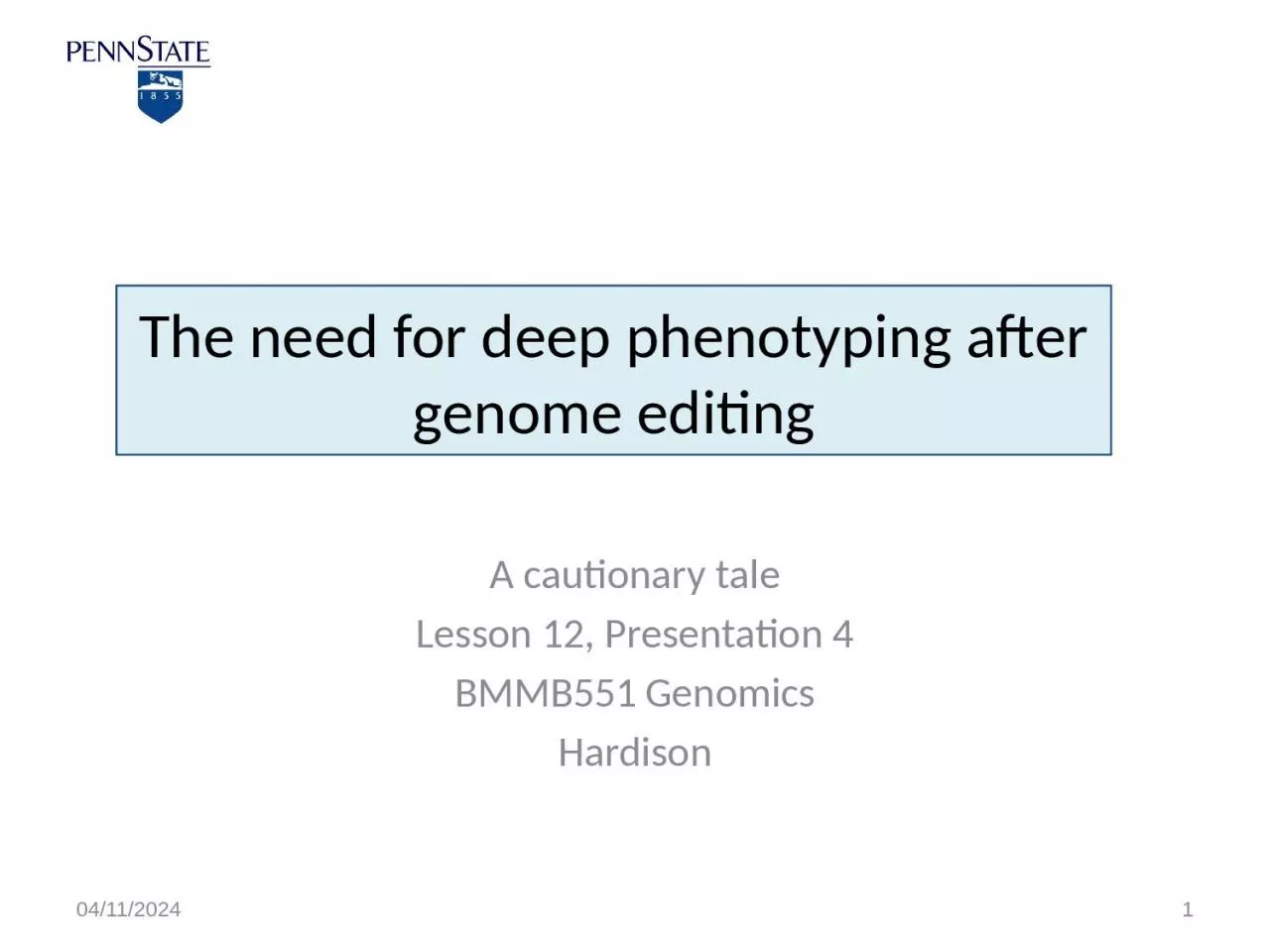

after genome e diting A cautionary tale Lesson 12 Presentation 4 BMMB551 Genomics Hardison 42615 1 Genome Editing Removal modification or addition of a functional element into the genome of a living cell or organism ID: 935208
Download Presentation The PPT/PDF document "The need for deep phenotyping" is the property of its rightful owner. Permission is granted to download and print the materials on this web site for personal, non-commercial use only, and to display it on your personal computer provided you do not modify the materials and that you retain all copyright notices contained in the materials. By downloading content from our website, you accept the terms of this agreement.
Slide1
The need for deep phenotyping after genome editing
A cautionary taleLesson 12, Presentation 4BMMB551 GenomicsHardison
4/26/15
1
Slide2Genome Editing Removal, modification, or addition of a functional element into the genome of a living cell or organism
Genes, regulatory regionsRandom changesInsertion of plasmids or viruses at any of many accessible targetsDirected changesHomologous recombinationSequence-specific DNA binding macromoleculesProtein domains: Zn fingers, TALEs
RNA: CRISPRLoss-of-function assays can be definitive, but they do sometimes show no phenotype for strong gain-of-function enhancers4/26/15
2
Slide3Highly constrained noncoding sequences are frequently tissue-specific enhancers
Pennacchio et al. (2006) Nature 444: 499-502
Slide4Implications of enhancer activities in highly constrained sequences
Non-coding regions that are conserved at an unusually high level are highly enriched in enhancers located near developmental genes
We
should be able to predict many enhancer regions based on
strong sequence constraint
Assumption
: These regions are sequence constrained because of functional constraint
Slides edited from:
Jonathan
McGovern
BMMB 541
4/30/09
Slide5Deletion of Ultraconserved Elements Yields Viable Mice
Nadav Ahituv, Yiwen Zhu, Amy Holt, Veena Afzal, Len A. Pennacchio and Edward RubinPLoS Biology, September 2007
But…
Slide6Selection of Ultraconserved Enhancers
KO PHENOTYPE
KO PHENOTYPE
Dmrt1
: Male sexual development abnormalities
Pax6
: Eye defects, lethality, CNS, craniofacial, pituitary and pancreatic abnormalities
DNA polymerase: Assumed Lethal
ATP11C:
Assumed Lethal
Dmrt3:
Male sexual development abnormalities, lethal due to dental malformation
WT1:
Wilms tumor, kidney defects, lethality, mesothelium defects, heart/lung malformation
ARX:
Lethality, male sexual development abnormalities, small brain
Sox3:
Abnormal sexual development and pituitary function, mental retardation in humans
Slide7Successful Knock-Out
KO PHENOTYPE
KO PHENOTYPE
Dmrt1
: Male sexual development abnormalities
Pax6
: Eye defects, lethality, CNS, craniofacial, pituitary and pancreatic abnormalities
DNA polymerase: Assumed Lethal
ATP11C:
Assumed Lethal
Dmrt3:
Male sexual development abnormalities, lethal due to dental malformation
WT1:
Wilms tumor, kidney defects, lethality, mesothelium defects, heart/lung malformation
ARX:
Lethality, male sexual development abnormalities, small brain
Sox3:
Abnormal sexual development and pituitary function, mental retardation in humans
Slide8Results for KO on autosomes
uc248 knockout :
-
Expected Phenotype
: Male reproductive abnormality, severe dental malformation
-
Observed Phenotype:
Normal reproductive capability (Table 4), normal dentition
uc329
knockout:
-
Expected Phenotype
:
Wilms
tumor, WAGR syndrome, other kidney abnormality, eye abnormalities
-
Observed Phenotype
: ~2% unilateral renal agenesis (compare to 0.5% in
wt
), normal eyes
Table 2 (Expect 1:2:1 Ratio)
Slide9uc482
knockout: -
Expected Phenotype: Hypopituitarism, hypoparathyroidism, growth hormone deficiency (reduction in weight
),
sexual abnormality
-
Observed Phenotype
:
Normal
reproductive capability, normal weight, normal calcium levels
Results
for X-linked KOs
Table 3 (Expect 1:1:1:1 ratio)
Figure 2
uc467 knockout:
-
Expected Phenotype
: Perinatal mortality, small brain, male sexual reproductive abnormality
-
Observed Phenotype
: Normal brain, normal reproductive
capability,
normal
survival
Slide10Practically Perfect Mice
No gross pathological differences
100% survival over 25 weeks
Normal weight
Normal clinical chemistry
Normal reproductive ability
Slide11Loss of highly conserved regulatory regions leads to insignificant (if any) phenotypeMaybe there is phenotype outside lab or over time
Regulatory element redundancy probableThe idea that highly conserved non-coding regions are hotspots for developmental enhancers is not being challenged but it raises the question…
What prevents sequence change?
Summary #2
Slide12Deep phenotyping can reveal defects from enhancer deletions
4/26/1512
Attanasio
et al…Pennacchio,
Visel
(2013) Science 342:1241006
Predict
cranio
-facial enhancers by P300 ChIP-seq.
Delete candidate enhancers.
Look for phenotypes by
morphometic
analysis.
Slide13Genomics of Gene Regulation: Integration and Assays
Individual features can be good predictors, but they tend to point to similar regions EP300, tissue-specific TFs, H3K4me1, H3K27acIntegration of features by unsupervised machine-learning can reveal frequently occurring (and important) states
Debate over how good they are at predicting CRMsSupervised machine-learning (e.g. EnhancerFinder) does a good job of finding the enhancers it was trained to find: developmental enhancers
Significant progress in ramping up the scale of gain-of-function assays for enhancersLoss-of-function assays can be definitive, but they do sometimes show no phenotype for strong gain-of-function enhancers
4/26/15
13